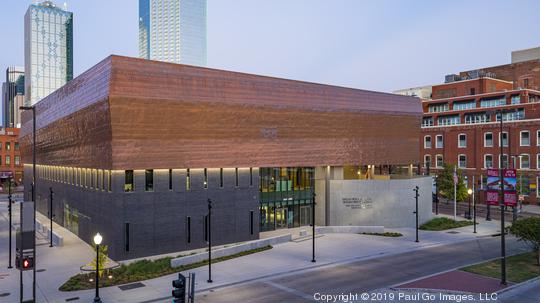
With each day that goes by, the memories of the past fade a little bit more. And each year, the stories people carry with them are lost, as survivors of war and the Holocaust pass away. But there are some doing the work to preserve their voices for future generations – and in some cases quite literally.
When the new location of the Dallas Holocaust and Human Rights Museum (DHHRM) opens to visitors next week, on Sept. 18, it will be showing off a lot of changes and renovations. A new space, new programming, even a new name (they’ve added the “and Human Rights” part to their title) – however, what is sure to be one of the most talked about new features at the museum is its Dimensions in Testimony exhibit.
“We’ve developed this tech that basically changes the way history is told, whether it’s the Holocaust or the history of rock n roll,” said Joel Solloway, President of Cleavland-based EventWorks4D – the developer of the tech used in the Dimensions in Testimony exhibit.
“The idea with the Holocaust survivors is to [record] them while they’re alive because you’ll never get the details in the stories by having someone digitally representing that.”
Dimensions in Testimony is an interactive experience for museum visitors. 91-year-old Dallas resident and Holocaust survivor, Max Glauben sat down with interviewers over the course of five days, recording hours and hours of his story from his time in the Warsaw Ghetto and Dachau to even some of the smaller details of his personal life. Then, USC Shoah Foundation, a nonprofit that compiles oral histories for Holocaust survivors, took the recordings to Conscious Display who used their hologram technology to recreate the scene in the new Dallas museum.
"We’ve developed this tech that basically changes the way history is told"
After watching a brief introduction video about Glauben, the curtain rises, and the Holocaust survivor is sitting in the room with visitors. Microphones around the room are able to pick up visitors’ questions, and they can hear answers directly from the projected image of Glauben. The recreation is incredibly life-like; Glauben even has a ‘resting-state’ while waiting for questions in which he blinks, nods and many other small movements that people have as they wait.
“The Dallas Holocaust and Human Rights Museum is honored to partner with USC Shoah Foundation and the Dimensions in Testimony℠ team to ensure that even after our Survivors are no longer with us, generations to come will still have the opportunity to hear their inspiring stories of resilience and hope by asking questions, hearing responses in real time, and learning about a devastating chapter in world history from those who experienced it first-hand,” said Museum President and CEO Mary Pat Higgins.
In addition to the Dimensions in Testimony exhibit, the museum is using tech in other areas to help create an immersive and engaging experience to visitors. As you walk down the various exhibits and sections of the museum, you are typically greeted and guided by video tour guides that interact with each other and provide context to each section.
According to Chris Kelley, DHHRM spokesperson, the engagement built into the experience is intentional. The exhibits focus on four types of people: victims, perpetrators, bystanders, and upstanders. Kelley said this is to get visitors thinking about how human emotion and relationships play into these types of tragedies, as well as about how they can take an active role in preventing hate in the modern day.
This ties in with the addition of “Human Rights” to the name of the museum. Kelley said this is because with the exhibits, the museum hopes to give more context and to show that hatred and genocide are not limited to mid-20th century Europe.
“A big part of our job is preserving the evidence,” Kelley said.
Construction on the new 55Ksq.-ft. DHHRM started in Oct. 2017, expanding the museum’s footprint by about 44K square feet. While the museum was hoping to raise $73.5M for the project, community support brought in more than $84M.
The museum is located at 300 N. Houston St. in Dallas, and even includes a new XD theater space by Cinemark.








